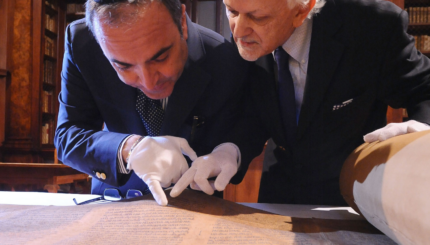The author begins the following article with the observation that prayer is not one of the mitzvot (commandments), by which he means that saying particular prayers at particular times prayer was a mitzvah instituted by the talmudic-era Rabbis rather than from the Torah. He goes on from there to explore what it means to truly live a life of prayer. Reprinted with permission from A Book of Life (Schocken Books).
It is striking that prayer is not a mitzvah according to most rabbinic authorities. One could say that there is no mitzvah to pray because none is necessary, prayer is a natural impulse. Or because prayer is beyond the system of mitzvot, it is not something to be done only at specific times and with specific words. Rather, prayer is a way of being.
"How many tefillot [prayers] is one required to utter every day? Our masters taught: One is to utter no more than the three tefillot, which the fathers of the world ordained. David came and specified the times: ‘Evening, morn, and noon" (Psalm 55:18). Hence, one is not permitted to utter more than three tefillahs a day. However, R. Yohanan said: Oh that one could continue to pray the entire day!’ (Midrash Tanhuma, Miketz, 9; Talmud, Berakhot 31a).
"’As for me, let my prayer be unto You, O Lord, in an acceptable time.’ For everything the Holy One set a time and a season, as is said, ‘There is a time for experience’ (Ecclesiastes 8:6)–except for prayer. Whenever people pray, they are answered. Why is there no set time for prayer? Were a person to know the time when, if they pray, they will be answered, they would leave off other times and pray only then. Accordingly, the Holy One said: For this reason I do not let you know when you will be answered, so that you will be willing to pray at all times, as is said, ‘Put your trust in God at all times’ (Psalms 62:9)" (Aggadah Bereshit 77).
With your help, My Jewish Learning can provide endless opportunities for learning, connection and discovery.
Opportunity for Self-Relfection
To live a prayerful life is to live a life of devotion. It is to carry with you an attitude toward the unfolding of your life. To always be praying is to live with an awareness of the true reality of nature.
"For prayer is not the shutting of one’s eyes to reality. It is the glimmer, the intimation, the daring which leads to the transcending of reality" (Jakob Petuchowski). Prayer leads us to an understanding of our limitations and our frailty as well as our capacity for goodness and greatness. As we pray, we become aware of all that lies beyond the self of the mountains and valleys of the psalmist, of the play of light and dark in the daily cycle of our world, of the birds and all the other creatures singing praise to God, and finally of all of creation. As we achieve the correct perspective of being only a small dot in a vast universe, we can feel alone.
Moments of prayer in our busy lives become opportunities for self-reflection. Most often when we do that, when we gaze in the mirror of truth, not only do we see that we are only an insignificant dot in the universe, but the countenance staring back at us is an ugly one. We see all the bruises and warts on our faces earned in our lives. It is the portrait of Dorian Gray that we see rather than the prettified self we like to think we present to the outside world.
Some commentators understand the word for prayer, mitpalel, with its reflexive grammatical form, to mean "judge oneself." Prayer prevents us from being carried away with ourselves. Yet even as we gain true perspective and a truer sense of ourselves, we are not meant to berate ourselves for our failures. Nor are we meant to feel insignificant or that in the scope of the universe whatever we do or whatever happens to us is insignificant. Nor is the goal to achieve an equanimity that leads you to feel nothing matters. Nor to come to a realization that all life is just a passing breath, as in the imagery of Kohelet, Ecclesiastes.
For as small and as fallible as we are, as we encounter God in prayer we are reminded that we are created in the image of God. This means that each person is unique and each of us is called to act in Godly, that is, holy, ways.
No Place Absent of God
The Hasidic master Isaacher Baer of Zlochow taught on Genesis 44:18 the following: At first, when a person wishes to pray, he thinks of God’s greatness and says to himself: "Who am I, a mere flawed mortal, to pray before the great and exalted God." But upon further reflection, he realizes that there is no place absent of God, and therefore he, too, is part of the Divine. We are all created in the Divine image. With this understanding the person will now be able to pray with great enthusiasm.
Prayer becomes the expression of and evidence for our relationship to God. It is an affirmation that we are never alone, we always stand in relationship to the Holy One, who loves us with an everlasting love.
Prayer reminds us that God the Creator is everywhere in the universe, including, most importantly, in ourselves. To live a prayerful life is to see the image of God in every person we see, to see the everyday blessings of a blue sky and a green tree. In fact, it is to see the many blessings of our lives even as we don’t ignore the curses and the suffering that is inevitably our fate.
Standing on an empty beach, we look back across the sand stretching as far as the eye can see. Lost from our sight is not what lies beyond the horizon, but rather the millions of grains of sand lying at our feet. All those millions make up this sandy vista, but we only perceive the mass whole. A life of prayer is to make us aware of the millions of moments that together make up the sandy beach of our individual lives. As small as each of us is in the vista of the universe, as fleeting as this moment is, this moment and myself are integral parts of the tapestry of existence.
The challenge of prayer is even harder than we think. It is not only to pray three times a day in a minyan [prayer quorum], it is to be prayerful at every moment of the day. To know before Whom you stand, and to act and react to the world in a holy way.
"If prayer is pure and untainted, surely that holy breath that rises from your lips will join with the breath of heaven that is always flowing into you from above. Thus our masters have taught the verse: ‘Every breath shall praise God’: with every single breath that you breathe, God is praised. As the breath leaves you, it ascends to God, and then it returns to you from above. Thus that part of God which is within you is reunited with its source." (From the Hasidic work Keter Shem Tov, as adapted in Your Word Is Fire, by Arthur Green and Barry Holtz).
Hasidic
Pronounced: khah-SID-ik, Origin: Hebrew, a stream within ultra-Orthodox Judaism that grew out of an 18th-century mystical revival movement.
mitzvah
Pronounced: MITZ-vuh or meetz-VAH, Origin: Hebrew, commandment, also used to mean good deed.


